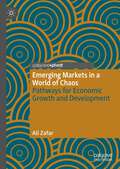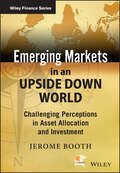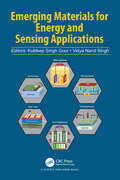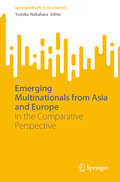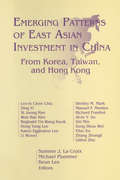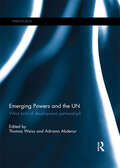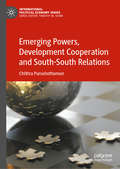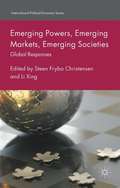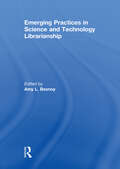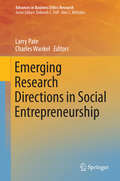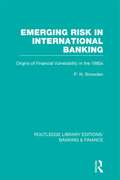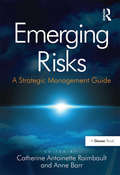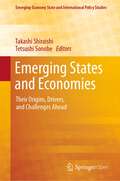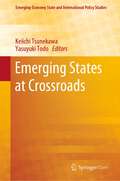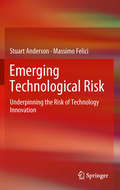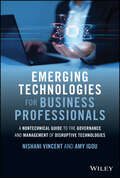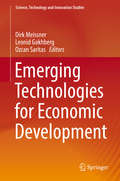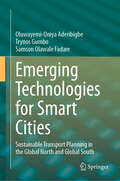- Table View
- List View
Emerging Markets in a World of Chaos: Pathways for Economic Growth and Development
by Ali ZafarThis book is a journey through leading and incredibly diverse emerging markets in a world of shocks and transitions. Tracing the rise of China, the emergence of India, the changing fortunes in Brazil, Argentina, and Mexico, the unique developments in Turkey and Indonesia, the complex geopolitics in Russia and Saudi Arabia, and the challenging post-apartheid transition in South Africa, the study examines their varying prospects in the years to come. Using an innovative analytical approach and rich empirics, the book delves into topics ranging from macroeconomics to human development, institutions to climate change. It provides a strategic roadmap of reform for these economies to escape the middle-income trap. It argues that in a world where advanced economies are defined by slowdown, growing trade blocs, changing demographics, and the rise of renewable technologies, emerging markets will continue to play a significant but complex role in the twenty-first century.
Emerging Markets in an Upside Down World
by Jerome BoothThe world is upside down. The emerging market countries are more important than many investors realise. They have been catching up with the West over the past few decades. Greater market freedom has spread since the end of the Cold War, and with it institutional changes which have further assisted emerging economies in becoming more productive, flexible, and resilient. The Western financial crisis from 2008 has quickened the pace of the relative rise of emerging markets - their relative economic power, and with it political power, but also their financial power as savers, investors and creditors.Emerging Markets in an Upside Down World - Challenging Perceptions in Asset Allocation and Investment argues that finance theory has misunderstood risk and that this has led to poor investment decisions; and that emerging markets constitute a good example of why traditional finance theory is faulty. The book accurately describes the complex and changing global environment currently facing the investor and asset allocator. It raises many questions often bypassed because of the use of simplifying assumptions and models. The narrative builds towards a checklist of issues and questions for the asset allocator and investor and then to a discussion of a variety of regulatory and policy issues.Aimed at institutional and retail investors as well as economics, finance, business and international relations students, Emerging Markets in an Upside Down World covers many complex ideas, but is written to be accessible to the non-expert.
Emerging Markets: Performance, Analysis and Innovation (Chapman & Hall/CRC Finance Series)
by Greg N. GregoriouAlthough emerging market economies consist of 50% of the global population, they are relatively unknown. Filling this knowledge gap, Emerging Markets: Performance, Analysis and Innovation compiles the latest research by noteworthy academics and money managers from around the world. With a focus on both traditional emerging markets and new areas, su
Emerging Materials for Energy and Sensing Applications
by Vidya Nand Singh Kuldeep Singh GourThe proposed book explores the latest advancements in materials science for energy generation, storage, and sensing technology. It covers various topics, including nanomaterials, 2D materials, thin film, quantum dots, solar cells, gas sensors, thermoelectric generators, photodetectors, water splitting, etc. This book highlights emerging materials' applications, making it an invaluable resource for researchers, engineers, and students looking to stay up-to-date in this rapidly growing field. Its focus on cutting-edge materials and their potential to develop energy harnessing and information gathering provides a deep insight into the exciting world of innovative materials.
Emerging Multinationals from Asia and Europe: In the Comparative Perspective (SpringerBriefs in Economics)
by Yumiko NakaharaThis is the first book that provides a comprehensive inter-regional comparison of Asian and European multinationals from large (China and Russia) and medium-sized (Taiwan) emerging markets. Utilizing novel findings of the top-notch theoretical research on internationalization of emerging market multinational enterprises, the book shows selected empirical evidence that some emerging multinationals from the respective countries have successfully nurtured their competitive advantages by an effective synthesis of both globalization and domestic market benefits. Multinational enterprises from emerging markets have become an essential part of the world economy in the twenty-first century. The book introduces distinctive examples of emerging market multinationals from Asia and Europe that are no longer simple suppliers to the world-famous brand firms from developed countries. The book is a rarity in that it attempts to link the micro-analysis of specific features and strategies of emerging multinationals with the macro-analysis of foreign direct investment and global value chain participation of the respective countries. The book is valuable for both scholars and students in the fields of international business, international economics, and international political economy as well as for businesspeople aiming to enhance their understanding of the heterogeneity and complexity of multinationals from emerging markets.
Emerging Needs and Opportunities for Human Factors Research
by Committee on Human FactorsThis book identifies areas that represent new needs and opportunities for human factors research in the coming decades. It is forward-looking, problem oriented, and selectively focused on national or global problems, including productivity in organizations, education and training, employment and disabilities, health care, and environmental change; technology issues, including communications technology and telenetworking, information access and usability, emerging technologies, automation, and flexible manufacturing, and advanced transportation systems; and human performance, including cognitive performance under stress and aiding intellectual work.
Emerging Nokia?
by Tarun Khanna Rakeen Mabud Mary Furey Juan AlcacerBy late 2009, Nokia was grappling with the decision of whether to recover its leading position in the high-profit developed markets, where they were losing market share to the likes of Apple and Samsung, or defend its market leadership in the low-margin, high-volume emerging markets. This case poses the following questions: Should Nokia stay the course, operating in both the developed and emerging markets, or should they forego one for the other? And what would this imply for the types of handsets and services they would need to offer?
Emerging Pathogens at the Poles: Disease and International Trade Law (Routledge Research in Polar Law)
by Alexandra L. CarletonEmerging Pathogens at the Poles: Disease and International Trade Law explores the applicability and possible complicating issues of the SPS Protocol to the Polar Regions in light of emerging pathogeneses and unknown host and environmental susceptibility and resilience. It examines the current literature on emerging pathogeneses in the Arctic and Antarctic and the relationship pathogeneses has with human development and movement of goods and people in spreading pathogens in the Polar Regions. Given the endemic nature of the Polar environment and the increasing interest in these regions for tourism and industry, this topic is important to address. The major component of the work is on the relevance of the SPS Protocol and the GATT 1994 Article XX(b) exception on human, animal and plant health as a barrier to trade which is examined in the context of its application to the Arctic and Antarctic. This book is an introduction to the interdisciplinary thinking required, across both science and law, in order to appreciate the significance of global trade barriers in reducing disease transmission and spread. The spread of pathogens across boundaries has become an important geopolitical issue and the provisions of international trade law may prove decisive in limiting or exacerbating the spread of disease. Academics and students with initial knowledge of the international trade regime, or those with initial studies in health or Polar medicine, will find this cross-over a useful introduction to the complications of food, trade and disease.
Emerging Patterns of East Asian Investment in China: From Korea, Taiwan and Hong Kong
by Sumner J.La CroixFocuses on the recent surge of foreign and Taiwan investment to mainland China's coastal provinces. The 15 papers presented in this text provide data on the emerging pattern of East Asian investments in China and an understanding of the mistakes of early investors.
Emerging Powers and the UN: What Kind of Development Partnership? (ISSN)
by Thomas G. Weiss and Adriana Erthal AbdenurThe post-2015 goals and the changing environment of development cooperation will demand a renewed and strengthened UN development system. In line with their increasing significance as economic powers, a growing number of emerging nations will play an expanded role in the UN development system. These roles will take the form of growing financial contributions to individual organizations, greater weight in governance structures, higher staff representation, a stronger voice in development deliberations, and a greater overall influence on the UN development agenda. Emerging Powers and the UN explores in depth the relationship of these countries with, and their role in, the future UN development system. Formally, the relationship is through representation as member states (first UN) and UN staff (second UN). However, the importance of the non-public sector interests (third UN) of emerging economies is also growing, through private sponsorship and NGO activities in development. This book was originally published as a special issue of Third World Quarterly.
Emerging Powers in the WTO
by Constantine MichalopoulosThe most important dimension of globalization in the last thirty years and especially since 2000 has been the dramatic increase of developing country participation in world trade and the emergence of a number of powers such as Brazil, China and India that are playing an important role in the global economy and in the WTO. But many other developing countries continue to struggle to transform their economies, handicapped by institutional constraints and protection against their exports both in developed and developing country markets. This volume examines the main factors for developing country trade performance in the last thirty years, their own trade policies, market access issues they face, and their increasingly more effective participation in the WTO and the Doha Round of multilateral trade negotiations. The last part addresses the future role of the WTO in the international trade system in connection with the challenges it faces from the multitude of preferential trade agreements such as the Transatlantic Trade and Investment Partnership between the US and the EU; and recommends an action program for the more effective participation of developing countries in the world trade.
Emerging Powers, Development Cooperation and South-South Relations (International Political Economy Series)
by Chithra PurushothamanThis book analyses the role of emerging powers as a development assistance providers and the nature of their development cooperation, their behaviour, motives and markedly their changing identities in international relations. With their growing economic and political clout, emerging powers are using economic instruments like foreign aid to ensure their position in the international system that is going through power shifts. By comparing three major emerging economies of the Global South- Brazil, India and China- this book would explore how emerging powers are changing the international aid architecture that is created and dominated by the traditional donors.
Emerging Powers, Emerging Markets, Emerging Societies: Global Responses (International Political Economy Series)
by Li Xing Steen ChristensenThe rise of emerging or new powers has recently become one of the most researched areas in International Relations. While most studies focus on relations between traditional and emerging powers, this edited collection turns the focus 180 degrees and asks how countries outside these two power sets have reacted to the emerging new world order. Are emerging powers creating a united front in a struggle to change the global order, or are they more concerned with national interests? Are we seeing major changes in the global order, or simply an adjustment by the traditional powers to the emergence of new contenders? In order to the answer these questions, the authors take a broad thematic approach in analyzing recent trends in the interplay between states, markets and societies, concentrating in particular on Latin America, Africa, the Middle East and Europe, and on the three major emerging powers: China, India and Brazil.
Emerging Powers, Global Justice and International Economic Law: Reformers of an Unjust Order?
by Andreas BuserThe book assesses emerging powers’ influence on international economic law and analyses whether their rhetoric of reforming this ‘unjust’ order translates into concrete reforms. The questions at the heart of the book surround the extent to which Brazil, Russia, India, China, and South Africa individually and as a bloc (BRICS) provide alternative regulatory ideas to those of ‘Western’ States and whether they are able to convert their increased power into influence on global regulation. To do so, the book investigates two broader case studies, namely, the reform of international investment agreements and WTO reform negotiations since the start of the Doha Development Round. As a general outcome, it finds that emerging powers do not radically challenge established law. ‘Third World’ rhetoric mostly does not translate into practice and rather serves to veil economic interests. Still, emerging powers provide for some alternative regulatory ideas, already leading to a diversification of international economic law. As a general rule, they tend to support norms that allow host States much policy space which could be used to protect and fulfil socio-economic human rights, especially – but not only – in the Global South.
Emerging Practices in Science and Technology Librarianship
by Amy L. BesnoyThis book investigates the emerging practices of science and technology librarians specific to maintaining collections, providing access to resources, and ensuring that informed decisions are made regarding limited financial resources. Issues discussed include librarians becoming embedded in curriculum design and delivery, the continuum of librarian involvement, science literacy and the intersection with lifelong learning, integration of information literacy into science, technology, engineering and mathematics (STEM) curriculum, development of course-related instruction programs. In addition, chapters include the differentiation between locating and accessing content and the economics of access, data driven collection and retention decisions, social networking and the scientific community, the trend to merge IT with libraries, institutional repositories, and managing productivity.Each chapter considers the change that is occurring in and around the profession and together these chapters present a notable set of reflections on the changes that are necessary for science and technology librarians to thrive in the shifting information landscape. This book is recommended for scholars and professional librarians.This book was published as a special issue of the Journal of Library Administration.
Emerging Real Estate Markets
by David LindahlPraise for Emerging Real Estate Markets "In this book, you'll discover how to snatch real estate opportunities at low prices, before their value becomes common knowledge. Buy all the copies on the bookshelf before your competitor does!" --Frank McKinney, "The Maverick Daredevil Real Estate Entrepreneur" and author of Frank McKinney's Maverick Approach to Real Estate Success "I've never seen another real estate book even come close to laying out a profit road map the way this one does. If your local economy is too hot or too cold, Lindahl's guide will show you how to invest in the up-and-coming markets with the greatest profit potential. " --Stacy Kellams, President, www. RealEstateCourseReviews. com "Lindahl shows you how to look into the future and see where the next hot real estate markets will be. It's the closest thing I've found to a real estate crystal ball. " --Jeff Adams, President, www. FreeRealEstateMentoring. com "The brilliant thing about this book is Lindahl's approach to investing by 'remote control. ' He has a real-world system for living in one place and making money from investments in another. " --William Bronchick, attorney and coauthor of Flipping Properties "In the crowded field of real estate gurus, Lindahl stands head-and-shoulders above the rest. This book is must reading for any serious investor--beginner or veteran. " --Justin Ford, author of Seeds of Wealth and Main Street Millionaire
Emerging Research Directions in Social Entrepreneurship
by Larry Pate Charles WankelThis book takes an inside-out approach to examine the broad topic of social entrepreneurship. Instead of looking inward at what social entrepreneurship is, this book looks forward from the view of successful social entrepreneurs to answer the important question, "Where is social entrepreneurship going next?" First, the volume looks at the essential qualities of social entrepreneurs, including the importance of humility as a trait in the social entrepreneur, the way in which social entrepreneurs define themselves as such, and if and how opportunity recognition differs in social and traditional entrepreneurs. Next, the volume looks at the impact of social entrepreneurial businesses on individuals but also on the supply chain, other businesses and the wider community. Next, the book explores social entrepreneurship and global change. This rare and compelling section, offers key insights and lessons in the development and promotion of social entrepreneurship in the global economy. This volume addresses both theory and research, suggesting practical solutions. It engages scholars and practitioners across disciplines in an examination and debate about various methods and approaches of enacting programs of social change.
Emerging Risk in International Banking: Origins of Financial Vulnerability in the 1980s (Routledge Library Editions: Banking & Finance)
by P N SnowdenGlobal payments imbalances and the rise of emerging economies provide the background to this analysis of risk exposure and near-insolvency at the world’s major banks. Emerging Risk was published in 1985, three years after the first international banking crisis of the post-War era, but prior to resolution after 1989 of the underlying sovereign debt overhang. With episodes of international financial instability punctuating the following quarter century until the Lehman collapse of 2008, this re-issue will contribute to the historical perspective on modern diagnoses of policy weakness and financial sector excess that is clearly needed. Whereas OPEC price increases in the 1970s were a source of the earlier global imbalances, Chinese surpluses and those occasioned by her rapid growth among commodity and oil producing countries are today’s equivalents. Emerging Risk documents the earlier poor employment of surplus funds ‘recycled’ to Latin America, much as the failure of the USA and others to use Asian financing productively is now evident. The role of the main global banking institutions in each of these outcomes reveals common threads. As a reading of Emerging Risk will confirm, both the special consequences of free competition in a global banking market, and the perverse incentives inherent in the remuneration of loan officers, were clearly present in the mid-1980s. The interaction of regulation and the competitive response of banks to produce increased reliance on wholesale borrowing and lending, together with enhanced gearing, have clear echoes in modern debates over the consequences of the Basel provisions.
Emerging Risks: A Strategic Management Guide
by Anne BarrFor boards and executives, high-quality and transparent information is critical to allow effective decision-making. Emerging risks are increasingly challenging issues, both in terms of threats and growth opportunities; not least since the science pertaining to these risks tends to be contested. Emerging Risks: A Strategic Management Guide restores the constructive dialogue between the business professional and the expert/scientist community, essential if companies are to anticipate, plan ahead and exploit leading-edge ideas. It provides insights into some of the major emerging risks of the 21st century and then guides organizations on how to approach and manage those risks proactively in the wake of new regulation, governance and enterprise-wide risk management. The topics covered include: nanotechnologies, covering the industrial revolution of the 21st Century; new information and communication technologies (NICT), discussing the infrastructure of the future; electromagnetic fields (EMF) and their debated health impact; chemical substances/REACH, a regulation with major economic and environmental stakes and an example of emerging risk management; biological risk and its on-going need for international surveillance; supply chain, a top management priority; and country risk, for which security and corporate social responsibility (CSR) are growing issues. The authors assess and propose a process for managing emerging risks and the strategies that need to be put in place, drawing on examples of best practice.
Emerging States and Economies: Their Origins, Drivers, and Challenges Ahead (Emerging-Economy State and International Policy Studies)
by Tetsushi Sonobe Takashi ShiraishiThis open access book asks why and how some of the developing countries have “emerged” under a set of similar global conditions, what led individual countries to choose the particular paths that led to their “emergence,” and what challenges confront them. If we are to understand the nature of major risks and uncertainties in the world, we must look squarely at the political and economic dynamics of emerging states, such as China, India, Brazil, Russia, and ASEAN countries. Their rapid economic development has changed the distribution of wealth and power in the world. Yet many of them have middle income status. To global governance issues, they tend to adopt approaches that differ from those of advanced industrialized democracies. At home, rapid economic growth and social changes put pressure on their institutions to change. This volume traces the historical trajectories of two major emerging states, China and India, and two city states, Hong Kong and Singapore. It also analyzes cross-country data to find the general patterns of economic development and sociopolitical change in relation to globalization and to the middle income trap.
Emerging States at Crossroads (Emerging-Economy State and International Policy Studies)
by Keiichi Tsunekawa Yasuyuki TodoThis book is open access under a CC BY-NC-ND license.This volume analyzes the economic, social, and political challenges that emerging states confront today. Notwithstanding the growing importance of the ‘emerging states’ in global affairs and governance, many problems requiring immediate solutions have emerged at home largely as a consequence of the rapid economic development and associated sociopolitical changes. The middle-income trap is a major economic challenge faced by emerging states. This volume regards interest coordination for technological upgrading as crucial to avoid the trap and examines how various emerging states are grappling with this challenge by fostering public-private cooperation, voluntary associations of market players, and/or social networks. Social disparity is another serious problem. It is deeply rooted in history in the emerging states such as South Africa and many Latin American countries. However, income distribution is recently deteriorating even in East Asia that was once praised for its high economic growth with equity. Increasing pressure for political opening is another challenge for emerging states. This volume argues that the economic, social, and political problems are interwoven in the sense that the emerging states need to build political consensus in order to tackle the economic and social difficulties. Democratic institutions have not always been successful in this respect.
Emerging Technological Risk
by Massimo Felici Stuart AndersonClasses of socio-technical hazards allow a characterization of the risk in technology innovation and clarify the mechanisms underpinning emergent technological risk. Emerging Technological Risk provides an interdisciplinary account of risk in socio-technical systems including hazards which highlight: · How technological risk crosses organizational boundaries, · How technological trajectories and evolution develop from resolving tensions emerging between social aspects of organisations and technologies and · How social behaviour shapes, and is shaped by, technology. Addressing an audience from a range of academic and professional backgrounds, Emerging Technological Risk is a key source for those who wish to benefit from a detail and methodical exposure to multiple perspectives on technological risk. By providing a synthesis of recent work on risk that captures the complex mechanisms that characterize the emergence of risk in technology innovation, Emerging Technological Risk bridges contributions from many disciplines in order to sustain a fruitful debate. Emerging Technological Risk is one of a series of books developed by the Dependability Interdisciplinary Research Collaboration funded by the UK Engineering and Physical Sciences Research Council.
Emerging Technologies for Business Professionals: A Nontechnical Guide to the Governance and Management of Disruptive Technologies
by Nishani Vincent Amy IgouEmbrace emerging technology in your own organization with jargon-free and practical guidance In Emerging Technologies for Business Professionals: A Nontechnical Guide to the Governance and Management of Disruptive Technologies, a team of accomplished accounting systems experts and educators delivers a straightforward and jargon-free management and governance blueprint of emerging technologies ideal for business professionals. In this book you will learn how to use cutting-edge technologies, including AI, analytics, robotic process automation, blockchain, and more to maintain competitive advantage while managing risks. The authors provide real-world examples and case studies of each of the discussed technologies, allowing readers to place the technical details in the context of identifiable business environments. Each chapter offers simple and useful insights in new technology that can be immediately applied by business professionals. Readers will also find: Discussions of a host of new computing technologies, including edge, cloud, and quantum computing Exploration of how the disruptive technologies such as metaverse and non-fungible tokens will impact business operations Easy-to-understand explanations of the latest, most relevant technologies with applications in accounting, marketing, and operations An essential resource for Certified Public Accountants, CPA candidates, and students of accounting and business, Emerging Technologies for Business Professionals will also earn a place in the libraries of anyone interested in adopting emerging technologies in their own organizations.
Emerging Technologies for Economic Development (Science, Technology and Innovation Studies)
by Leonid Gokhberg Dirk Meissner Ozcan SaritasThis book provides an impressive overview of emerging technologies, especially nanotechnologies and biotechnologies, and their prospective applications. It identifies and describes existing and potential markets for emerging technology-based applications, and projects scenarios for macroeconomic development based on these technologies. Integrated roadmaps for the development of a nano- and bioindustry are shown and policy measures and corporate strategies developed to advance these technologies. These measures are illustrated using roadmaps and policy case studies.The book combines a practical, comprehensive overview of the technical side of emerging technologies and their applications in various fields with an analysis of market developments and characteristics.
Emerging Technologies for Smart Cities: Sustainable Transport Planning in the Global North and Global South
by Samson Olawale Fadare Trynos Gumbo Oluwayemi-Oniya AderibigbeThis book examines the use of smart city-associated technologies to enhance sustainable transportation planning in cities of both the global north and south, focusing specifically on sustainable transportation. The authors of the book examine technologies and tools such as UAVs, GIS, cutting-edge information and communication technologies, machine learning and big data to assess their potential for reducing traffic, redirecting traffic to assigned routes, monitoring traffic growth and development in our urban centres, with the ultimate aim of reducing congestion/commuting time, accidents, and pollution to promote climate action and a just transition. The book offers a comparative study of transport situation and planning in the developed and developing countries, focusing on the United States of America, Germany and Singapore in the Global North on one hand and South Africa, Nigeria and India from the Global South on the other. As more and more of the world’s population lives in urban centers, proactively monitoring and managing car traffic is essential. The book will be of interest to academics and researchers in the built environment (architecture, urban and regional planning, construction management, quantity surveying, geography), engineering, environmental sciences, social sciences, public policy, design in both the developed and developing countries.
